Recent Articles
Popular Makes
Body Types
2021 Chevrolet Tahoe Road Test and Review
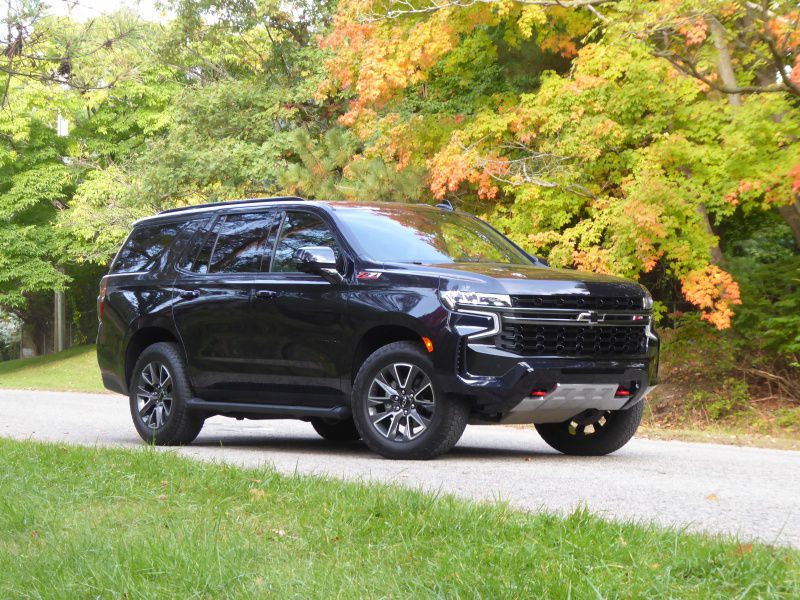
2021 Chevrolet Tahoe ・ Photo by Ron Sessions
Ever since Chevrolet introduced the Tahoe as a short-wheelbase version of the venerable Suburban a quarter-century ago, the Bowtie brand’s junior full-size SUV has been a market success. Stretching more than 17.5 feet bumper to bumper, the 2021 Chevrolet Tahoe is hardly junior to most SUVs on the road today, but it does fit in more garages than the nearly 19-foot-long Suburban. And it offers the same seating capacity of seven to nine passengers, the same 8,000-plus-pound towing capacity, and 85 percent of the maximum cargo capacity of the extra-long Chevy SUV.
That combination of attributes has helped make the Tahoe the top-selling full-size SUV for decades. But the recent redesign of the Ford Expedition has cut into the Tahoe’s sales lead and exposed the Chevy’s deficits in third-row seat room, load-floor height, ride quality, safety, and infotainment tech. The 2021 Tahoe addresses these issues with an all-new product that’s bolder, more tech-savvy, and a bit larger. The Tahoe lineup for 2021 includes the base LS, mainstream LT, well-equipped Premier, sporty RST, off-road-oriented Z71, and a new range-topping High Country. Prices change little from 2020. Including the $1,295 destination charge, 2021 Tahoe rear-drive models range from $50,295 to $70,895. Four-wheel drive is a $3,000 upcharge except on the Z71, which features standard 4WD.
New Chassis
With a larger grille, slender LED lighting, and overall styling cues inspired by the Silverado pickup, the 2021 Tahoe is all-new from road to roof. The new Tahoe grows in wheelbase and overall length to achieve relative parity in passenger and cargo space with its principal marketplace competitor, the Ford Expedition. Also, like the Ford Expedition, the 2021 Tahoe gains an independent rear suspension, ditching the live rear axle the Tahoe has used since its 1995 inception.
Independent rear suspension transforms the Tahoe’s dynamics, improving ride quality over rough or uneven surfaces, steering response, stability, and overall precision. Available on High Country and our tested Z71 model is an automatic load-leveling and ride-height-adjusting air suspension. The system lowers the ride height by three-quarters of an inch on the highway to aid fuel economy. Off-road, the driver can raise the suspension up to 2 inches to increase ground clearance. When parked, the driver can also lower the Tahoe 2 inches to aid loading and unloading. Magnetic Ride Control, already in use in other General Motors products such as the Chevrolet Corvette and Camaro and Cadillac CT5, is standard on High Country and Premier and optional on Z71. It reads the road and adjusts the damping of each shock individually for optimum control.
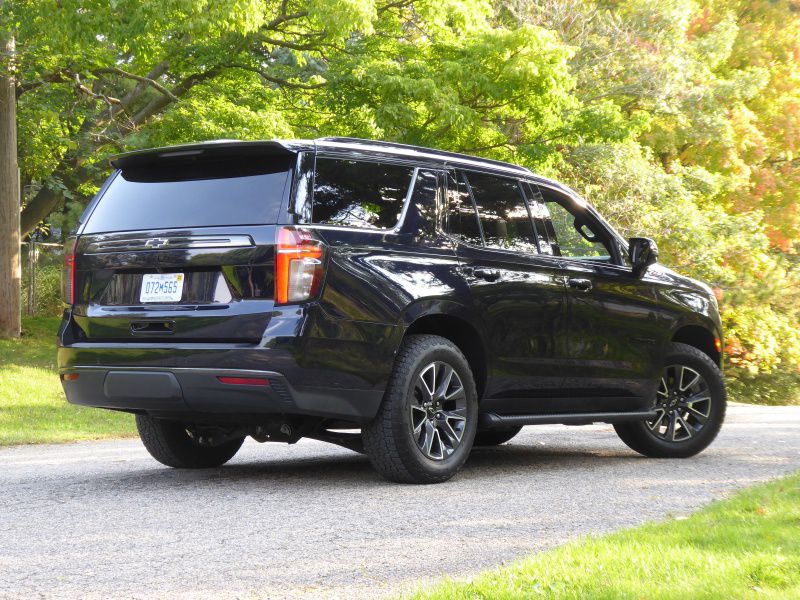
Photo by Ron Sessions
Trio of Powerplants
Engine choices include well-proven direct-injected 5.3-liter and 6.2-liter small-block gas V8s, largely carry over from the 2020 model, and an all-new 3.0-liter turbodiesel, due out later in the 2021 model year. A 10-speed automatic transmission, co-developed with Ford, is now standard with all engines.
The 5.3-liter V8 is standard in all 2021 Tahoes but the range-topping High Country. It pumps a more-than-adequate 355 horsepower and 383 lb-ft of torque and can hit 60 mph in about 7.5 seconds. EPA estimates are 16 mpg city/20 mpg highway for both rear- and four-wheel drive models. The brawnier 6.2-liter V8 powers the High Country. It’s rated at 420 hp and 460 lb-ft of twist and can power to 60 mph in approximately 6.5 seconds. Its EPA estimates are 15 mpg city/20 mpg highway for rear-drive and 14 mpg city/19 mpg highway for 4WD. The all-new 3.0-liter inline-6 Duramax turbodiesel is rated at just 277 hp but a healthy 460 lb-ft of torque. The diesel Tahoe’s EPA estimates haven’t been finalized, but 4WD versions of the mechanically similar Silverado pickup with this engine get a 22 mpg city/26 mpg highway rating. The standard towing rating for V8s is 7,600 to 7,900 pounds, while a max towing package bumps it to 8,100 to 8,400 lbs.
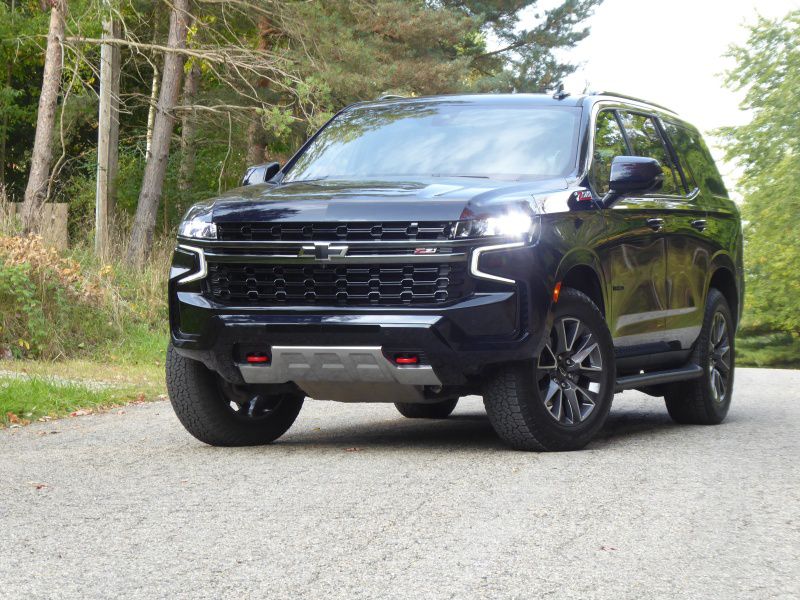
Photo by Ron Sessions
Push-Button Shift
Surprise, surprise. With the new Tahoe, Chevrolet has joined Honda, Acura, Lincoln, Hyundai, and GMC, moving from column- or floor-mounted shift levers to a set of buttons on the dash. The buttons are large and easy to reach without leaning forward.
The logic is less clutter and room for more storage on the now-movable center console as well as a bridge to the sorts of controls coming in future electric versions. To help drivers avoid selecting the wrong drive range in a hurry, such as when making a three-point U-turn on a busy street, engineers designed the buttons to be actuated differently. You push the “P” or “N” button to select Park or Neutral and pull the “R” or “D” to choose Reverse or Drive. When shifting manually, such as when driving twisty mountain roads, slippery winter conditions, or towing, the driver pushes the “L” button for transmission Low and then the plus or minus buttons flanking the L to upshift or downshift.
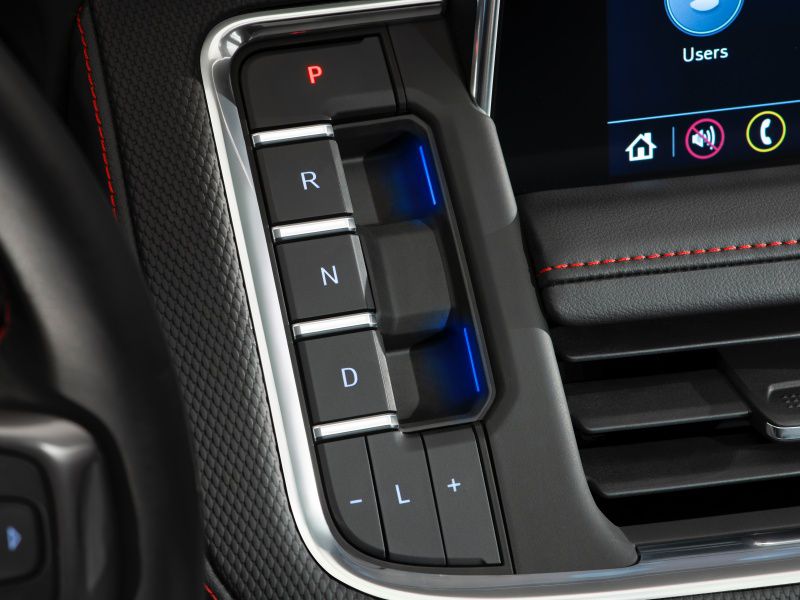
Photo by Chevrolet
Full-Size Refuge
There’s a lot going on in the Tahoe’s interior with myriad switchgear populating most of the dash. But what is there is well-organized and easy to access on the fly. The cabin is exceptionally quiet with a minimum of road, engine, or exterior traffic noise intruding. The front bucket seats, power-assisted on all grades, are large and comfortable. The overall feeling is one of roominess.
Considering the Tahoe costs as much as a mid-size luxury sedan, its materials and fit and finish are solidly middle-class but durable-looking. The base LS gets cloth-covered seats. LT, RST, and Z71 trims upgrade to leather and Premier, and the High Country adds soft perforated leather. Heated front seats, standard in lower trims, upgrade to heated and ventilated ones in the Premier and High Country. A 60/40 front bench is an option for those buyers seeking nine-passenger seating. An automatic heated steering wheel is aboard with Premier and High Country as well. An easy-to-use, set-and-forget tri-zone automatic climate control system comes standard with all trims. Also standard are a leather-wrapped steering wheel, push-button start, keyless entry, remote start, rain-sensing wipers, and a manual tilt/telescopic steering wheel. Premier and High Country models upgrade to a power tilt/telescopic steering wheel. Optional on upper trims is a large panoramic sunroof.
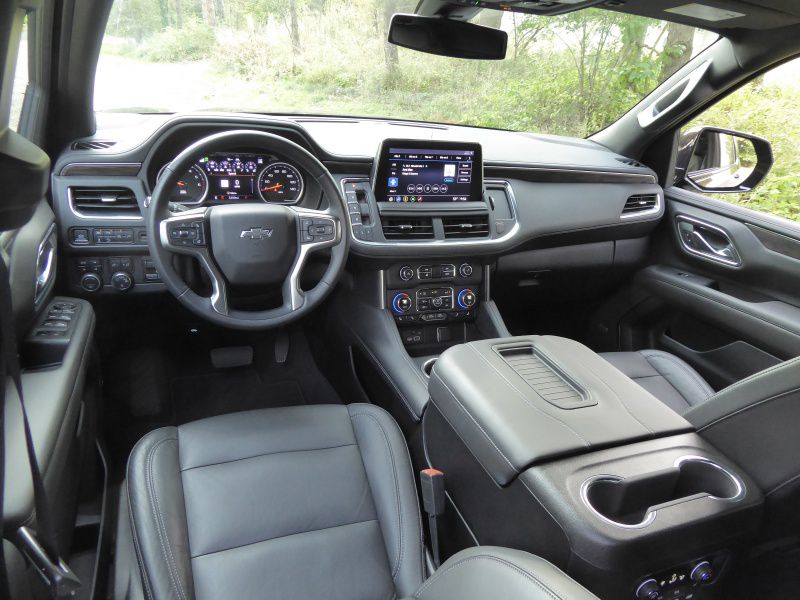
Photo by Ron Sessions
Infotainment 3 Plus
Standing proud on the upper center of the dash is a high-resolution, landscape-format 10.2-inch infotainment touchscreen. It replaces the 8-inch unit in last year’s Tahoe. The screen has vibrant colors and graphics. Large screen tiles make it easy to tap your selection on the fly the first time. Further down on the center stack are handy analog volume and tuning knobs plus shortcut hard buttons for home, back, and station scanning. Steering wheel and voice controls add further flexibility. All Tahoe models provide in-vehicle 4G LTE Wi-Fi.
The big news this year is the move to wireless Apple CarPlay and Android Auto cellphone mirroring. This helps eliminate some of the cable clutter, even though there are plenty of USB ports, both Type A and Type C, for hooking up other devices. A wireless charging pad on the console is included with LT and higher trims. The base audio on LS models is a six-speaker AM/FM system with standard HD radio and SiriusXM with 360L capability. LT, RST and Z71 trims upgrade to a nine-speaker Bose system, with topline Premier and High Country models getting an enveloping 10-speaker Bose surround-sound setup as well as an embedded navigation system.
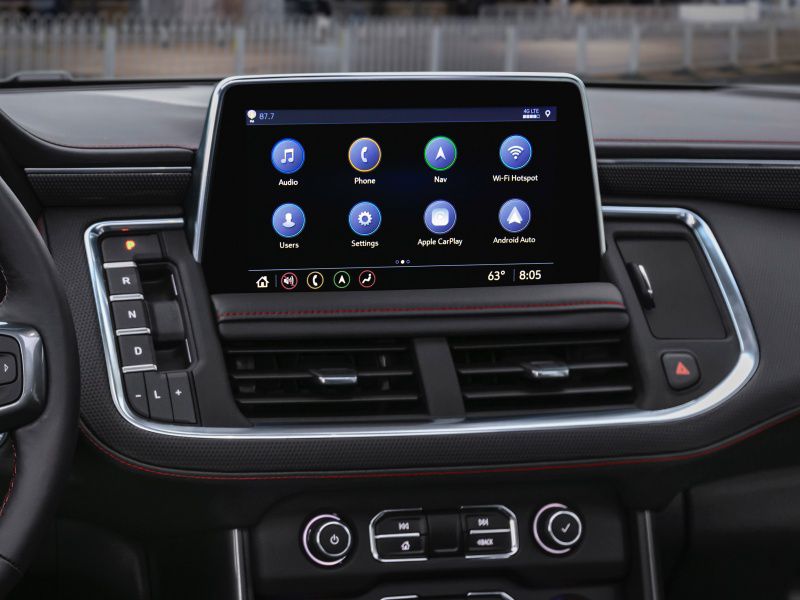
Photo by Chevrolet
Second-Row Sliders
For the first time, the Tahoe comes standard with sliding second-row seats. Whether the Tahoe is equipped with a 60/40 split-folding second-row bench or dual second-row captain’s chairs, both can be moved fore and aft up to 5.5 inches. This not only allows passengers to divvy up available legroom between the second and third rows, but it also eases entry through the rear doors into the third row. It was a real squeeze getting back there in previous iterations of the Tahoe. Overall, second-row legroom is increased 3 inches for 2021 over last year’s model, a big improvement.
Also available for the aft quarters is an all-new rear-seat entertainment system featuring a 12.6-inch high-res screen on each front seatback. The dual screens have HDMI inputs and each can display different content simultaneously. Passengers can mirror content from an Android phone, send navigation points to the main screen up front, and share content from one rear screen to another. Heated outboard second-row seats are available on top Tahoe trims.
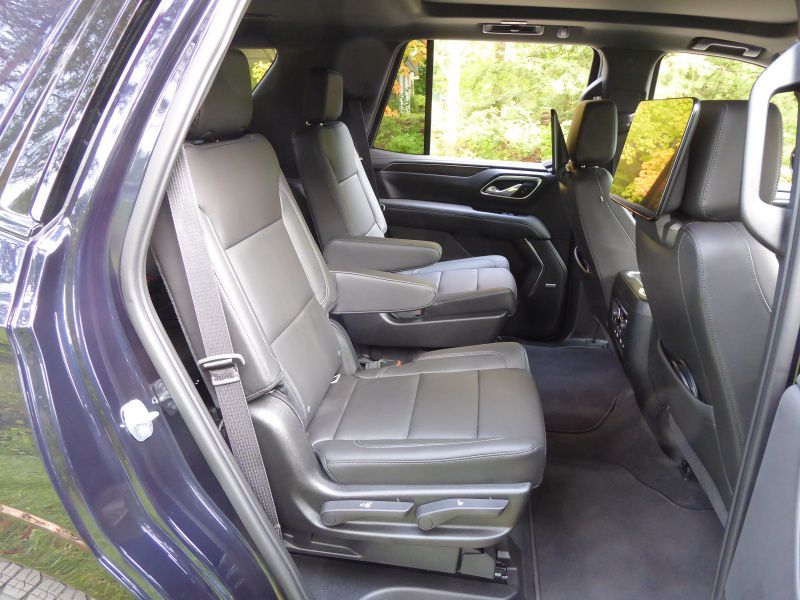
Photo by Ron Sessions
Adult-Rated Third Row
Thanks to a wheelbase stretch and its first-ever independent rear suspension, the 2021 Tahoe has a lower floor and a whopping 10 inches more third-row legroom than its predecessor (although still with slightly less legroom back there than the Ford Expedition offers).
Adults assigned to the 60/40 split third-row bench no longer have to tuck their knees under their chins just to fit in steerage. Also, because the second-row seats now slide forward against the front seatbacks, ingress and egress into the third row is much easier, although passengers have to step over the second-row seat tracks while making their passage.
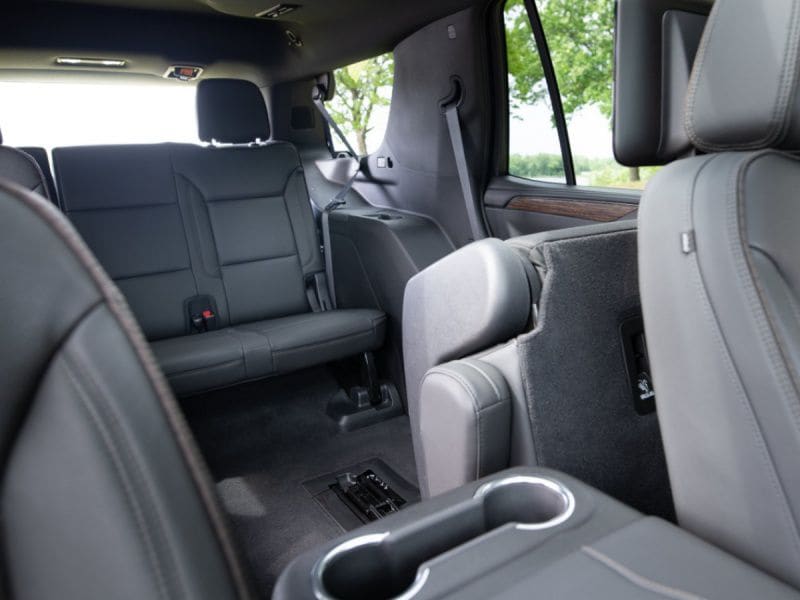
Photo by Chevrolet
More Cargo Space
Thanks to a lower cargo floor, loading and unloading objects from the 2021 Tahoe is now much easier. The lower floor and half-foot of extra length also contribute mightily to the new Tahoe’s overall cargo capacity. At 25.5 cubic feet, space behind the third seat nearly doubles compared to the 2020 model, while total space with both the second and third rows lowered jumps by nearly 30 cubic feet to 122.9 cubic feet. A cargo management system that helps keep items from rolling around back there is standard.
Power-folding third-row seats and power releasing second-row captain’s chairs — available on all but the base LS trim — make it easy to configure the vehicle for cargo duty. So does a hands-free power liftgate, operable by waving a foot between the rear bumper and a Chevy bowtie logo projected onto the pavement. That’s also standard on LT and higher trims. A rear cargo shade accessory is also available to keep valuables out of the hot sun and away from larcenous eyes.
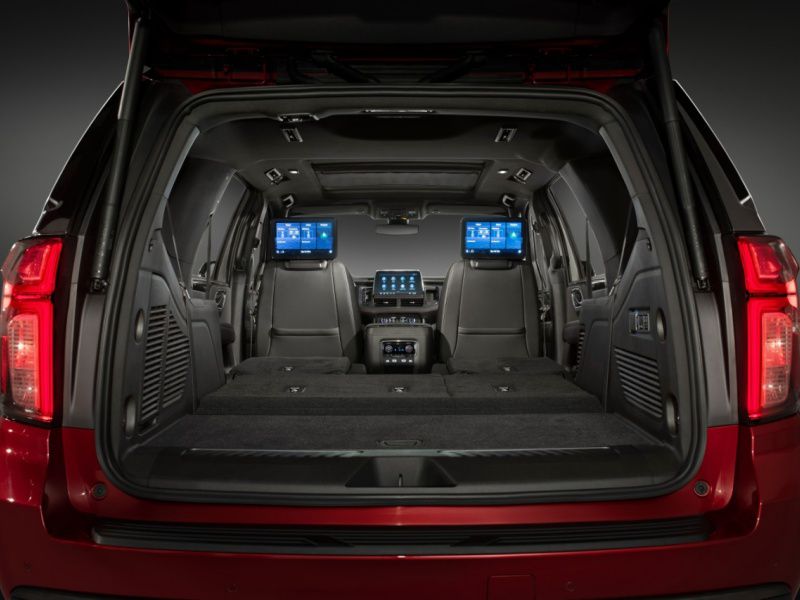
Photo by Chevrolet
Safety and Driver-Assistive Tech
It’s a long list, but safety is always top of mind in a large family vehicle. Chevrolet has expanded the roster of standard safety tech in Tahoe for 2021. Standard fare on all Tahoe trims includes a following distance indicator, automatic emergency braking, front pedestrian braking, a forward collision alert, rear park assist, automatic high beams, an HD backup camera with multiple angles and hitch guidance, and a rear-seat reminder asks you to check the back seat for a child or pet left behind if a rear door has been opened since the engine was last started.
The Premier adds a lane-departure warning, lane-change assist, a rear cross-traffic alert, blind-spot monitoring for the vehicle and a trailer, front park assist, and a safety alert seat that vibrates the driver’s lower seat cushion in the direction of a threat needing attention. The High Country brings a 360-degree surround-view camera, a rear pedestrian alert, a rear camera mirror that gives a view out the back window unobstructed by rear headrests or passengers, and a large head-up display in the lower part of the windshield for key driving information. Adaptive cruise control is optional on the Premier and High Country trims.
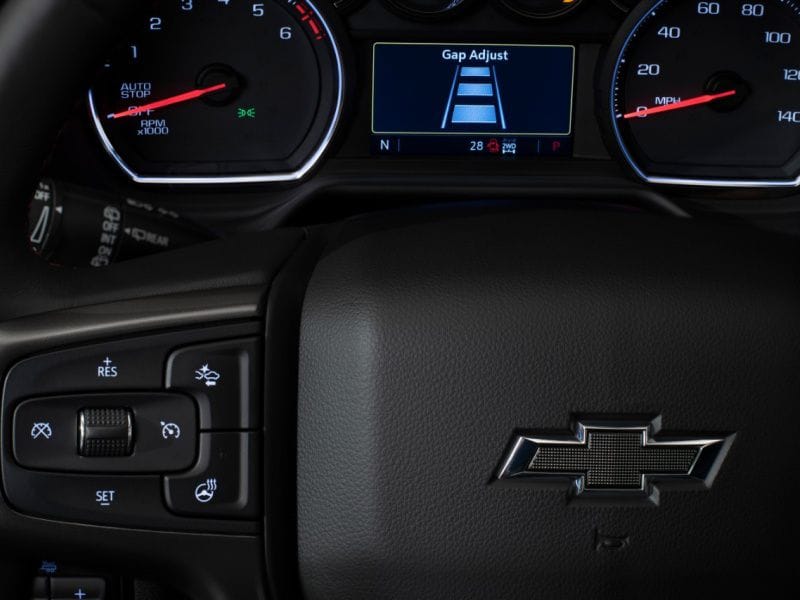
Photo by Chevrolet
Conclusion
The Chevrolet Tahoe has topped the full-size sport-utility sales charts for years despite not offering the best cargo or third-row passenger space or the latest safety and infotainment tech. That’s because the Tahoe has, for more than two decades, delivered good value for the dollar.
For 2021, Chevrolet addresses previous shortcomings while upping the ante with greatly improved ride and handling, easier loading, advanced safety and infotainment features, and a soon-to-launch ed fuel-efficient turbodiesel powertrain.
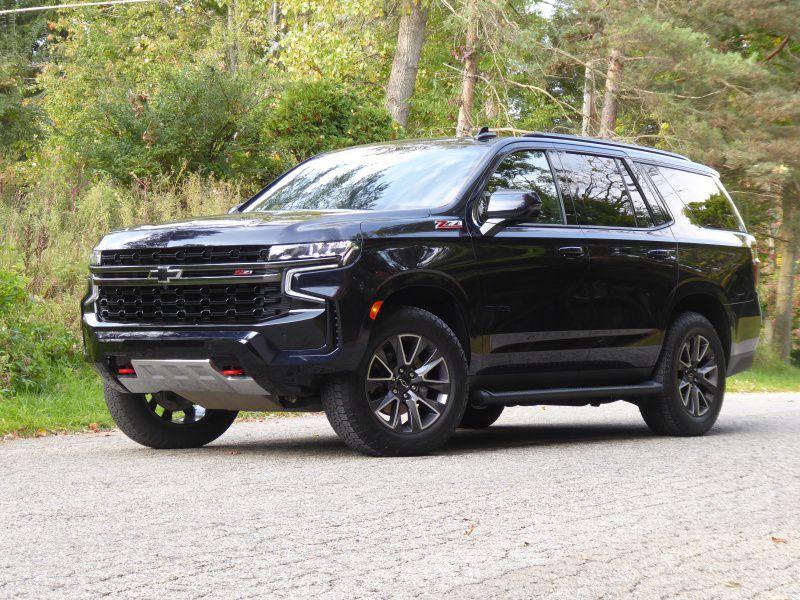
Photo by Ron Sessions